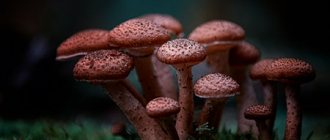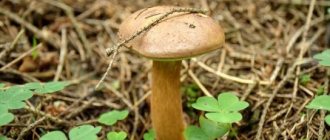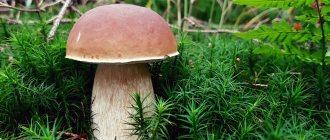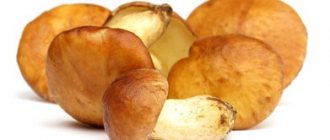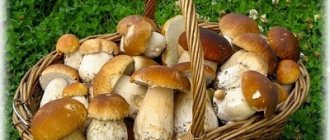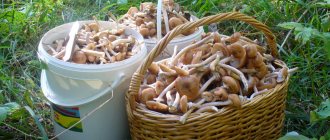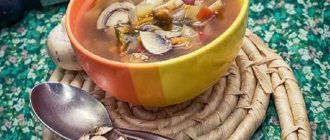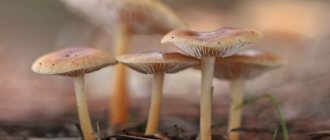Pleshakov, the author of textbooks and workbooks on the subject of the world around us in the Perspective and School of Russia programs, constantly gives tasks to look at the information in the atlas “From Earth to Sky.” But what if you don't have an atlas? The solution is simple! View this information in our atlas. The topic of mushrooms and lichens is studied already in the 2nd grade of primary school. The identification atlas is made up of the most common mushrooms growing in Russia; from it you can find out whether the mushroom in front of you is edible or inedible. You can buy it in bookstores or download it somewhere on the Internet. But there are no photographs in that atlas. And, as you know, an artist’s drawing and a photo are completely different things, and often it is almost impossible to recognize a mushroom from a drawing in life if you see such a mushroom for the first time. We have created a much more informative atlas and highlighted the topic of mushrooms in a separate article with colorful, life-like photographs, from which it is easy to determine what kind of mushroom is in front of you, whether it is edible or not. Here is this page: ABOUT MUSHROOMS FOR CHILDREN >> And here we have collected basic information about mushrooms and lichens.
Pushkin did it!
Message plan
- Why is it important to know about poisonous plants and mushrooms?
- What poisonous mushrooms should not be touched in the forest:
- death cap;
- thin pig;
- smelly fly agaric;
- gallerina bordered.
- Poisonous plants in our country:
- Sosnovsky's hogweed;
- raven's eye four-leaf;
- red-fruited crow;
- May lily of the valley.
- What do you need to remember to avoid poisoning yourself from poisonous berries and mushrooms?
For many Russian residents, their favorite pastime is picking mushrooms and berries. But before you go into the forest, you should study well the information about which plants and mushrooms are poisonous. This will warn you against possible danger. If substances harmful to his health enter a person’s body, he can become severely poisoned and even die.
Poisonous mushrooms
You need to remember a number of mushrooms that grow in the forests of Russia and can cause harm.
Death cap
Most often in the forest you can find a greenish or grayish mushroom with a white stalk. It is called the pale grebe. In a small mushroom the cap looks like an egg; in an adult it takes on a flat shape. You can confuse the toadstool with russula, which is an edible mushroom. But pale grebes have a peculiar ring on their stem. Eating toadstools is strictly prohibited. Even a small portion can lead to serious poisoning and death.
Thin pig
Previously, this mushroom was allowed to be canned in our country, but later it was recognized as deadly. The mushroom is a fleshy brown or brown cap with a greenish tint. The mushroom has a short stalk. You can meet a pig in a shady forest and even on a tree. They usually grow in whole groups.
The mushroom could previously be eaten because not everyone experienced symptoms of poisoning. However, later the pig was excluded from the list of edibles. The substances contained in these mushrooms can lead to kidney disease and respiratory failure.
Amanita stinking
The well-known red fly agaric is actually used for medicinal purposes, but you should not eat it, the mushroom is poisonous. His brothers pose a great danger. The stinking fly agaric is sometimes called the white toadstool for its characteristic color. The mushroom cap looks like a cone. Its leg is small, covered with flakes. Some mushroom pickers confuse this mushroom with champignons, so they risk poisoning.
You can find the mushroom in spruce or pine forests, and occasionally it grows among deciduous trees.
Galerina bordered
This is a very small mushroom. Usually they are found in a whole family, 10-15 mushrooms each. The mushroom has a brown cap and a thin white stalk with a border. You can see this dangerous mushroom in moss and on fallen trees. This family should not be confused with honey mushrooms, which also choose rotten trees for their life. But honey mushrooms have wide brown caps and legs.
It’s difficult to get poisoned by one gallery. But if you eat several mushrooms, then such a dose can be fatal.
Poisonous plants in Russia
Among our nature, on plains and meadows, in forests and fields, you can find plants that pose a danger to humans. Some of them should not only be eaten, but also touched.
Hogweed Sosnovsky
One of the poisonous plants growing throughout the country is hogweed. Its stem can reach a height of several meters. Hogweed has large leaves and white flowers that resemble umbrellas. The main danger is the juice of this plant. If it gets on the skin, then in sunny weather a severe burn will form at this place. Contact with hogweed pollen should also be avoided. There have been cases where it caused burns to a person's cornea, which led to blindness.
Crow's eye four leaf
At first, the bush of this plant may seem edible, since it is decorated with black berries. It is important not to confuse it with blueberries and blueberries. These berries rarely grow singly, but the crow's eye has only one fruit. The stem of the plant is green, with four large leaves.
Crow's eye can be found in many regions of the country, in forests where there is moist soil.
Red-fruited crow
Another plant whose berries attract people's attention is red-fruited crow. The bush grows up to 70 centimeters. It has pointed leaves with teeth. The berries on the bush grow green, gradually they turn red, becoming similar to viburnum. Bushes of a poisonous plant are found in coniferous or mixed forests.
Not only the berries are dangerous, but the entire plant.
May lily of the valley
The first spring flowers are very poisonous. Lilies of the valley have large green leaves and white inflorescences. They grow no more than 30 centimeters in height. Later, red berries appear in place of the flowers. Children can often taste them, which can lead to severe poisoning. The head begins to feel dizzy, nausea and noise appear. Lilies of the valley choose forest edges and shady areas.
To avoid poisoning, it is better not to eat suspicious berries and mushrooms, not to touch the leaves of plants and not to pick them. When walking through the forest, you need to be careful and take a first aid kit with activated carbon with you, just in case.
All answers to workbooks on the world around us, detailed analysis of complex tasks here
Emergency! Hello! My name is Maria, I am the author of the Pushkin website. I hope that my site helps you, in turn I ask for your help. Due to recent events and imposed sanctions, the mass departure of advertisers, the site’s income has approached zero, and the project is facing closure. So many years, so much effort invested. There are still a lot of plans to add new materials to the site. I can't cope without your help. PS. For my regular readers, if you remember what was written here earlier, the situation is improving significantly thanks to active daily activities, thanks to everyone who provided support. Collection page here
Similar
Poisonous plants
Poisonous plants are often found in the wild.
Aconite, or fighter, reaches a height of 1–1.5 m, is distributed throughout the country, prefers fertile, moist soils along rivers, and mountain meadows. The plant is so poisonous that it causes poisoning even from inhaling the smell. Therefore, gardeners processing plantings of cultivated aconite species wear clothing that covers the body, gloves and a protective mask. It is not recommended to include flowering plants in bouquets to decorate rooms. Accidental ingestion of small amounts of leaves can cause death.
In ancient times, hunters of the Slavic, Germanic and Gallic tribes rubbed the tips of arrows and spears with aconite juice, which they used against wolves, leopards and other large predatory animals.
Rice. 1. Aconite.
Crow's eye grows in shady, damp forests. A low plant with wide leaves and a single flower poses a mortal danger. Sometimes children try to eat the black, shiny berry, which ripens at the end of summer. The berry should not be picked up, as its juice if it gets into the mouth or eyes will cause serious poisoning.
In the message about poisonous plants, medicinal poisonous plants can be mentioned: wild rosemary, lily of the valley, hellebore, belladonna and others.
Before you start harvesting medicinal poisonous plants, you should learn about protection measures and collection times. The use of any composition as a medicinal product is possible under the supervision of a doctor or according to medical instructions.
Marsh wild rosemary is common in the tundra and forests of Russia. It grows especially luxuriantly in moss swamps and peat bogs. It belongs to evergreen shrubs, the average height is 0.4–0.6 m. It has a strong odor that causes headaches if inhaled for a long time. Harvesting of young shoots is carried out during flowering, and it is necessary to protect your hands with gloves.
Used in perfumery to control domestic insects. Essential oils, tinctures and herbal decoctions are used in medicine.
In case of poisoning, it affects the central nervous system.
Rice. 2. Ledum marsh.
Atlas-identifier of mushrooms for children
Mushrooms are a kingdom of living nature that unites organisms that combine some of the characteristics of both plants and animals.
And those cap mushrooms that we collect in the forest are only a small part of the entire diversity of this kingdom. Mushrooms are everywhere. They are widespread throughout the globe and are found on land, in water, and inside many plants and animals. Mold is also a mushroom.
The picture shows mold at high magnification.
There are such tiny mushrooms (they are more often called fungi) that cannot be seen with the naked eye, and they are constantly around us and even on our skin.
Fungi are thallus or thallus organisms. Their body consists of thin threads called hyphae, the abundantly branched system of which forms the mycelium, or mycelium. The mycelium absorbs ready-made nutrients from the environment to nourish and grow the fungus. In the cap mushrooms that we see in the forest, the mycelium is located underground, and above the ground there is a fruiting body consisting of a stem and a cap. We can eat the fruiting body if the mushroom is edible. Fungi reproduce by releasing very small particles called spores. New mushrooms grow from them.
Edible mushrooms, berries, herbs
— Vishnevsky M.V. “The most common edible mushrooms.” Reference guide. Astrel Publishing House, 2009.
— M.V. Gorlenko, M. A. Bondartseva, L. V. Garibova, “Mushrooms of the USSR”, Guidebook for Geographers and Travelers, Mysl Publishing House, Moscow, 1980, 303 pp.
— M. Vishnevsky, Edible mushrooms and their inedible and poisonous counterparts, a reference book in the format of comparative tables, East-West Publishing House, 2008, 48 pages.
- A. Dermek, Mushrooms, Slovart Publishing House, Kyiv-Bratislava, 1989
— Klepinina Z.A., Klepinina E.V., Mushroom Picker’s Handbook (1000 tips), AST-Press book, 2006, Moscow, 256 pages.
- L. A. Lebedeva, “Identifier of cap mushrooms”, State Publishing House of Agricultural Literature, Moscow, 1949.
— T. Litvina, “All about mushrooms. 100 edible and inedible mushrooms of Russia", St. Petersburg, Leningrad Publishing House, 2009, 256 pp.
- Maori Korhonen, 100 mushrooms, Moscow, Timber Industry, 1981, 168 pages, translated from Finnish.
— S.V. Rodionova, “Mushroom Picker’s Pocket Guide”, Moscow, Ed. Moscow worker, 1993, 122 pp.
- Yudin A.V., “The Great Guide to Mushrooms”, AST Publishing House, 2001, 256 ill. pages.
- B.V. Andrest, “Mushroom Basket”, Timber Industry Publishing House, Moscow, 1972, 192 pp.
— Vishnevsky M.V., “Inedible, poisonous and hallucinogenic mushrooms of the Moscow region,” Directory-atlas, Formica-S, 2001, 192 pages with illustrations.
- T.V. Lagutina, “The Complete Encyclopedia of Mushrooms”, Ripol-classic, Moscow, 2008, 377 pp.
— S.G. Matantseva, A.N. Matantsev, “Mushroom Picker’s Pocket Guide (more than 200 species)”, 452 pp.
— Pelle Jansen, “All about mushrooms. Directory.", translation from Finnish, Crystal, St. Petersburg, 2004, 160 pp. with illust.
— F.V. Fedorov, “Mushrooms”, third edition, revised and expanded, Moscow, Rosagropromizdat, 361 pp.
— Yu. I. Smirnyakov, A.K. Koshcheev, A.A. Koshcheev, “The Mushroom Picker’s Companion”, Moscow, Ecology, 1992, 303 pp. with illus.
— Yu.G. Semenov, “Complete illustrated guide to mushroom pickers”, MST Publishing House, 2001, 576 pp. with illust.
- B.P. Vasilkov, “Mushrooms”, publishing house of the USSR Ministry of Agriculture, Moscow, album, 1969.
— M.A. Bondartseva, “Identifier of mushrooms of Russia (order affilophorous, issue 2)”, Russian Academy of Sciences and Science Publishing House, 1998, 391 pp.
— M.A. Bondartseva, E. H. Parmasto “Identifier of mushrooms of the USSR (order affilophorous, issue 1)”, Nauka publishing house, 1986, 192 pp.
-WITH. B. Borisov, “Mushroom Picker’s Handbook”, Lenizdat, 1973, 48 pp.
— Nikitochkina T.D., Mushrooms. Issue 2. Second edition, 16 postcards, Kalinin Printing Plant Soyuzpoligraproma under the USSR State Committee for Publishing, Printing and Book Trade, Kalinin, 1987.
- L.V. Garibova, Artist A.K. Shipilenko, A Story about a Hundred Mushrooms, 32 postcards, Fine Arts, Moscow, 1990.
- Encyclopedia of mushroom picking /Auth. - comp. A. P. Umeltsev. - 5th ed., M: LOKID-PRESS, 2005. - 271 p.; ill., I5ВN 5-320-00480-Х.
— I. Ukhanova, Y. Manzhura, Mushrooms of Russia, reference book, Ripol Classic
Cap mushrooms
These mushrooms are conventionally divided into lamellar and tubular. Lamellar mushrooms include russula, saffron milk cap, and champignon. Their cap below has many thin plates that radiate from the stem like rays.
The cap of tubular mushrooms is pierced from below with small holes that continue into narrow tubes. In appearance you can compare it to a porous sponge. Tubular mushrooms include boletus and porcini mushrooms.
There are also mushrooms that have neither tubes nor plates. Among the edible ones, these are the puffball, and the conditionally edible ones are the morel and the string.
But this is not the only division of mushrooms. Mushrooms can be edible - these are those that can be immediately cooked and eaten, without pre-processing. conditionally edible mushrooms ; they need to be soaked in salted water or boiled and drained, and only then prepared for the dish. And there are inedible ones , they cannot be eaten. Many inedible mushrooms contain poison, others are simply bitter and tasteless.
Some poisonous mushrooms pretend to be edible by imitating their appearance. You need to be able to distinguish mushrooms in order to know whether they can be eaten and how to cook them. In fact, there are not so many cap mushrooms and remembering the main ones is not difficult.
